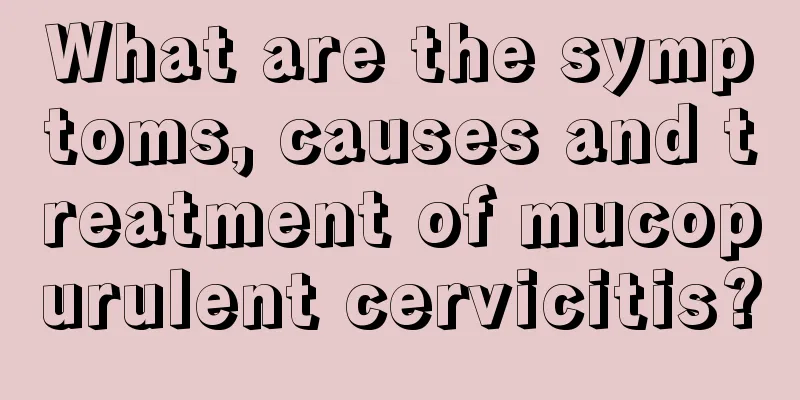How to treat cervical nabothian cyst

|
Cervical nabothian cyst is also called gynecological nabothian cyst. It is a symptom of chronic cervicitis. It is quite harmful to patients. It often causes dysmenorrhea and irritates the rectum. It can easily induce infertility symptoms in women. It often causes sexual intercourse pain, irregular menstruation, etc. For patients, good treatment should be carried out in time! Treatment methods include both Western medicine treatment and daily life treatment. General treatment Patients with Nabothian cysts have no clinical symptoms and are discovered accidentally during physical examination and do not require special treatment. If the glandular cyst is large and there are discomforts such as increased vaginal discharge, timely treatment is required. If the cyst is small and there are no symptoms, you can observe it first and go to the hospital for regular check-ups. Pay attention to the cleanliness of the vulva at ordinary times. If you find that the cyst is infected, rapidly enlarged, or you have any discomfort, go to the hospital for treatment in time. Western medicine treatment 1. For scattered and relatively small Nabothian cysts, the first priority is to determine whether there is vaginitis or cervicitis. Actively treating the primary disease can make the cyst improve or even disappear. This is one of the solutions for cervical retention cysts. 2. For dense or relatively large Nabothian cysts, phototherapy, laser, microwave, and other physical therapy methods can be considered. Regular follow-up visits based on clinical treatment records show definite efficacy. This is also one of the treatments for cervical retention cysts. 3. For cervical retention cysts, if they are larger and protrude from the surface of the cervix, electrosurgical resection or self-coagulation knife removal can be considered. prevention 1. Pay attention to hygiene at ordinary times and use weakly acidic female care liquid to clean the vulva to maintain the self-cleaning function of the vagina and prevent the invasion of pathogens. 2. Have sexual intercourse in moderation and avoid excessive sexual intercourse. Pay attention to sexual hygiene and the spouse should take care to remove the smegma on the penis. 3. Implement family planning, take contraceptive measures, and try to avoid mechanical damage to the cervix caused by multiple abortions. At the same time, gynecological surgical operations must be performed strictly aseptically to prevent iatrogenic infection and injury. 4. Avoid damaging the cervix during delivery. If cervical laceration is found, it should be sutured promptly and antibiotics should be used. 5. Pay attention to hygiene during menstruation, miscarriage and postpartum period. Sexual intercourse and bathing in a tub should be strictly prohibited during menstruation and after delivery to prevent pathogenic bacteria from taking advantage of the opportunity to enter. |
<<: Can I have sex with an ovarian cyst?
>>: Is third degree cervical erosion serious?
Recommend
How to distinguish the authenticity of latex pillows? How to clean latex pillows
There are many types of latex products on the mar...
Ooyala: 2017 Q2 Global Video Index Report
199IT original compilation Ooyala released the &q...
Menstrual headache and nausea
Menstruation is a physiological phenomenon that a...
How to prevent postpartum venous thrombosis
After giving birth, a woman enters the postpartum...
What should I do if I take two folic acid tablets a day?
Folic acid is one of the vitamins needed by the h...
What to do if a woman has pain on the left side of her lower abdomen
Many female friends have experienced discomfort i...
Uncover the hidden health "liver" disturbance of fat babies: non-alcoholic fatty liver disease!
Author: Wu Jingfang, deputy chief physician of Ch...
What to do if you often have vulvar itching
If a woman experiences long-term vulvar itching, ...
What are the causes of adnexitis? You should know these factors
Adnexitis is a common gynecological inflammation,...
Is polycystic ovary syndrome serious if hormone levels are normal?
Polycystic ovary syndrome with normal growth horm...
Can I get pregnant if I have sex 8 days after an abortion?
Nowadays, people have very open sexual attitudes,...
Blood sugar is unstable, are you eating right?
This is the 5295th article of Da Yi Xiao Hu We em...
Picture of female scrotal bulge
There are eight points in the Bladder Meridian, f...
What are the symptoms of cerebral infarction? Is constant dizziness related to cerebral infarction?
I sorted out some questions everyone asked and fo...
Is there any discharge during early pregnancy?
When it comes to female secretions, everyone know...



![[Nursing Science] Do you really understand nebulization inhalation in children?](/upload/images/67f148d680858.webp)





